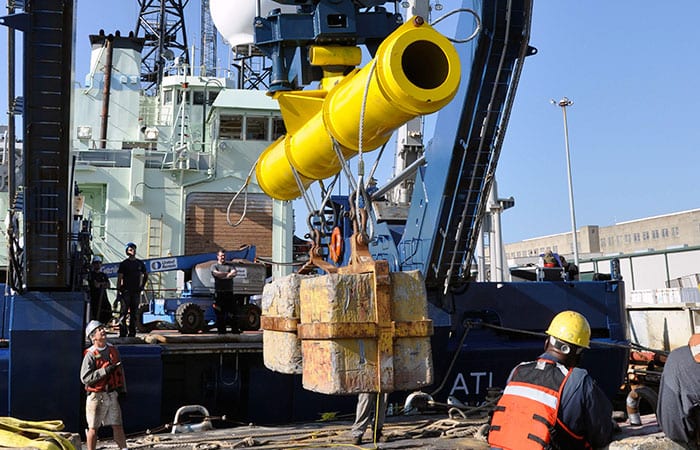
Rebuilding Alvin: Patrick Hennessy
A series on the people who reassembled the iconic sub
From the beginning of 2011 to May 2013, Alvin, the U.S. science community’s only human-occupied submersible dedicated to deep-sea research, underwent a thorough overhaul and upgrade to greatly enhance its capabilities. In the end, the iconic sub was redesigned and rebuilt, piece by piece, by a one-of-a-kind team of engineers, technicians, and pilots at WHOI.
Here, Bosun Patrick Hennessy discusses testing the A-frame on Atlantis:
What we’ve got going on in this photograph is that we’re testing the A-frame on the research vessel Atlantis after the A-frame’s re-assembly. The physical structure and the hydraulics have been upgraded to lift the upgraded, heavier Alvin. We’re trying to simulate the weight of the submarine and test the integrity of the A-frame and all its functions.
We’re using weights and a spreader bar [the yellow tube]. Actually, the spreader bar is called the “yellow submarine.” It’s an engineered piece of steel where we can apply weights at various areas and try to balance the distribution of the load longitudinally, as if it was the submarine.
I’m the eyes. I’m just watching everything, to make sure all these functions work. I’m talking with chief engineer Christopher Morgan up in the doghouse [windows above and behind the yellow submarine]. That’s where the operator is for the A-frame during launch and recovery.
We’re testing the main lift line and we’re testing the hook. On launch and recovery, when the A-frame goes in and out, the hook gets inserted into a “T” on the submarine, and that actually holds the weight.
We’re also looking at the strain on the A-frame. Over to the right [out of view] there’s a gentleman and a rack of computers, and along the starboard leg of the A-frame are all these sensors called strain gauges. What they’re measuring is the strain on the A-frame as the weight was exercised on it.
The ship was in drydock at Detyens Shipyard in Charleston, South Carolina, for cleaning and painting, and to complete the rebuild of the A-frame. At the shipyard, they test a lot of different crane systems, so they have all these various certified weights, so when you say, ‘We need this amount of weight,’ they can get all these together and you get the weight you want.
In this photo there’s about 46,000 pounds. The Alvin’s going to be approximately 46-47,000 pounds. We started from zero weight so we could see the strain the A-frame went under when there’s no weight on it, just going back and forth. Then we slowly added weights in 25,000-pound increments, until we were up to 100,000 pounds. That’s about double the weight of the submarine, so what you’re doing is building in a factor of safety. The testing went on for at least five days.
I went to school for chemistry and I have a lot of physics, and that helps me in my job. Working at sea, there’s a lot of dynamics involved, especially working over the side, doing moorings, doing submarine work, launching boats. I’ve been working for WHOI going on 20 years now. I started working on the Eagle Mar, and I slowly worked my way up, what they call “through the hawsepipe.”
I was born and raised in this town, and I’m very proud to be working for WHOI and to be involved with this project. I’d like to see it come to fruition and be very successful.
Alvin is owned by the U.S. Navy and operated by WHOI. The current upgrade has been funded largely by the National Science Foundation, with support from private donations to WHOI.
From the Series
Related Articles
- The story of a “champion” submersible
- Robots to the Rescue
- Who is Alvin and what are sea trials?
- 7 Places and Things Alvin Can Explore Now
- The story of “Little Alvin” and the lost H-bomb
- Meet the Alvin 6500 Team: Lisa Smith
- Overhaul to take Alvin to greater extremes
- Meet the Alvin 6500 Team: Rose Wall
- Racing an undersea volcano
Featured Researchers
See Also
- Building the Next-Generation Alvin from Oceanus magazine
- Alvin Gets an Interior Re-design from Oceanus magazine
- New Personnel Sphere Passes Pressure Test WHOI News Release
- Human Occupied Vehicle Alvin
- Alvin's Pilots from Oceanus magazine
- National Deep Submergence Facility
